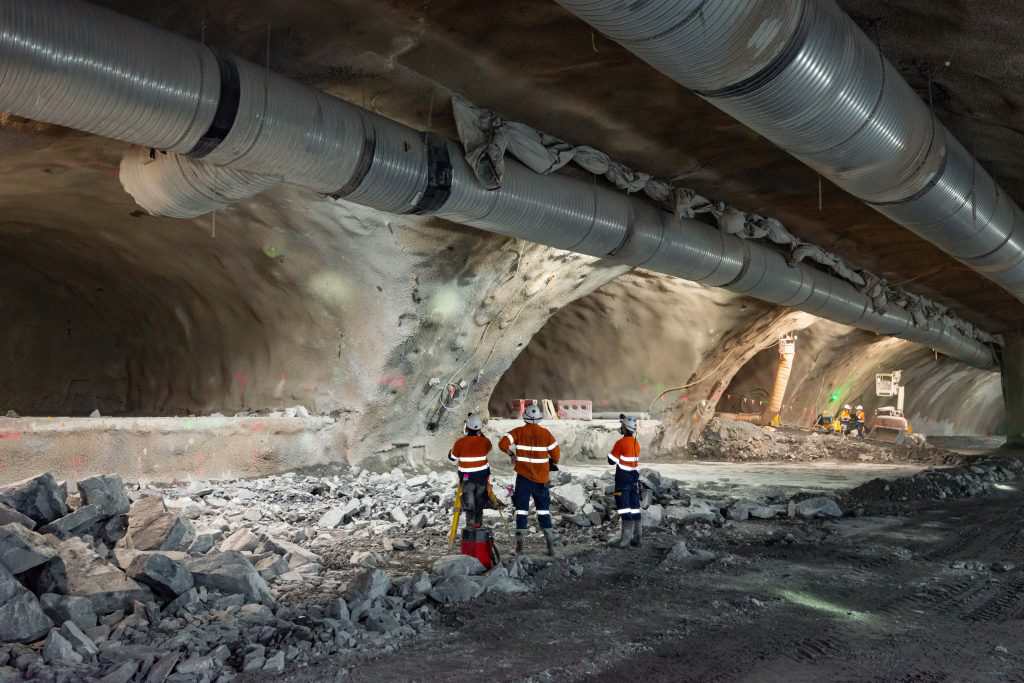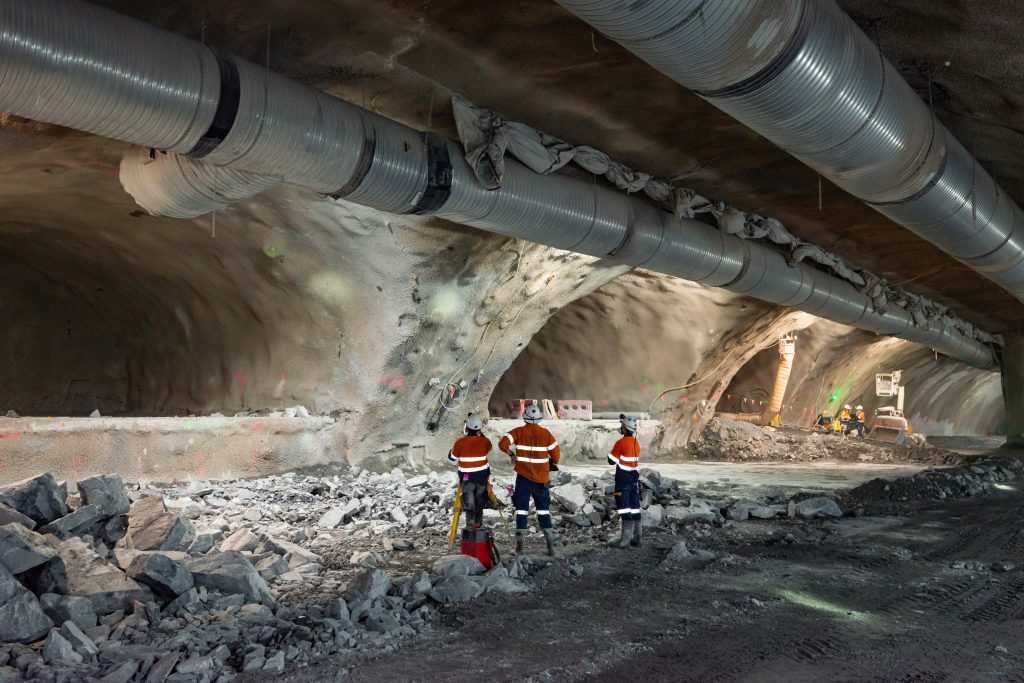
Cavern construction techniques are helping to minimise disruption during delivery of Brisbane’s new underground rail link.
Rail traffic in the Australian city of Brisbane, south east Queensland is currently constrained by a single bridge over Brisbane River, but work is underway to add capacity, reliability and connectivity to the region’s network. The solution is Cross River Rail, a new rail link with a tunnelled section through the city centre. It will boost the number of trains crossing the river from 16 to 18 per hour to 24 trains per hour.
Cross River Rail is 10.2km long and runs between Dutton Park and Bowen Hills with a central 5.9km long twin bored tunnel section. Four new stations with 220m long platforms – at Boggo Road, Woolloongabba, Albert Street and Roma Street – will also allow the network to carry nine car trains instead of the six car services which run at present.
Critical infrastructure
The Queensland Government has described the project as a “critical public transport infrastructure project” that will improve quality of life, boost the economy and activate urban development. It expects the population in south east Queensland to grow from 3.5M to 4.9M over the next 15 years with the main focus for employment growth expected to be the city centre, placing further pressure on the transport network.
Despite the clear need for the scheme, getting to the construction phase has not been straightforward. Plans to increase public transport capacity across the city have been mooted for more than 25 years with various combinations of rail-only, bus-only and combined train and bus options considered on a number of different routes. However, a new state government in 2017 gave the project the political support it needed and work started to push ahead on the rail solution – now known as Cross River Rail – soon after the election.
CBGU JV a joint venture between CPB, Bam, Ghella and UGL secured the design and build contract from Pacific Partnerships, the public private partnership company set up to deliver the project which is budgeted at A$5.4bn (£2.9bn), and construction got underway in late 2019. Robert Bird Group (RBG) was brought in as CBGU’s technical partner for the station and portal design at tender stage and developed the design after contract award.
According to CPB general manager engineering Ron Thomas, who until earlier this year was design director for CBGU, the original call for tenders included significant oversite development.

“The rival bid to CBGU’s focused on that element of the work and stuck close to the reference design, which called for the use of open box construction for the stations,” he explains. Thomas describes this approach as very disruptive and the CBGU design used a full cavern design – as opposed to top down open ground construction – for two of the major stations to reduce issues with utility diversions.
“Moving the utilities at Albert Street to allow box construction could have taken two years,” says Thomas. “There were also technical challenges and disruption issues with the box approach.”
Boggo Road is the southernmost of the underground stations. Due to its shallow depth with platform level just 19m below ground level and because of its highly fractured metamorphic ground conditions, it is being built using a combination of open box and cavern construction.
Moving the utilities at Albert Street to allow box construction could have taken two years
Further north, the next station on the line is Woolloongabba. It is a full cavern station next to The Gabba cricket ground, so shafts for the lifts and escalators from platform level to ground level were a key part of the design as they needed the capacity to handle match day crowds. The platform level here will be 27m below ground level.
The station caverns will be 270m long, 22m wide and 25m high to create room for the 220m long platforms.
RBG general manager Dylan Walmsley is project director for delivery of RBG’s work on Cross River Rail for main contracting joint venture CBGU. He puts the scale of the caverns into context by saying that the maximum height for high rise buildings in Brisbane is just over 270m.
Ground conditions at Woolloongabba are better than at Boggo Road. Thomas says that 4m above the excavation the conditions are the same fractured rock as at Boggo Road but the excavation itself is in competent ground.
Next on the new line is Albert Street station which is 31m below ground and has a cavern the same size as Woolloongabba’s. Here the ground conditions are much more challenging with very hard rock with strengths of up to 120MPa. The other cavern structures are being excavated by roadheaders, but at Albert Street CBGU will also use drill and blast techniques.
The tunnel boring machines have broken into Roma Street
The cavern lies directly below the street and has two shafts – one at the north end and one at the south end to the side of the main cavern excavation. “The southern shaft, which will be the main entry in
terms of capacity, is 50m deep, effectively making it the deepest basement ever excavated in Brisbane,” says Walmsley.
The depth is not the only challenge as the southern shaft is next to two 40m tall residential buildings with a fault passing below one of them. Extensive anchoring has been required during excavation and this imposes large forces on the permanent works.
RBG general manager east and technical director on Cross River Rail Scott Wheeler says that the completed southern shaft will be largely void of floor slabs to brace it due to the lifts and escalators. As a result it was a challenge to design it without internal supports. Excavation has just reached the halfway stage.
The completed southern shaft will be largely void of floor slabs to brace it due to the lifts and escalators
There is also a third shaft – known as lot 2 – but it is only being used as a temporary access point to allow cavern mining to progress independently from shaft construction. Under the reference design, this was to be a permanent shaft with an oversite development but CBGU’s temporary use of the site means that future development is not significantly restricted by the station infrastructure as there will be no permanent station structures left after construction is complete.
Work on the cavern excavation has reached the mezzanine level above the platform level while the tunnel boring machines have already passed through the site and have now broken through at the next station, which is Roma Street (see box).
Ground conditions are also a challenge at Roma Street station which extends 27m below ground. There, in addition to the hard rock, there is a fault zone to contend with. The cavern also underlies the main railway station while the escalator and lift shaft is on the site of the Roma Street bus station.
“The excavation process is limited by the existing infrastructure,” says Thomas. “The fault zone also means that there is a sudden change in ground conditions – we’re mostly excavating the cavern through highly foliated siltstone and sandstones. However, in the entry shaft – one side you hit hard rock at 2m but on the other side you’ve got 20m of alluvium and fill before reaching hard rock.”
Lift and escalator shaft
The lift and escalator shaft measures 40m by 40m and will provide access to the bus station and main railway station once complete. Roma Street also has a separate shaft for mechanical and electrical equipment, whereas this is integrated into the lift and escalator shafts at other stations on the project. According to Wheeler, this difference is down to the phasing of the demolition and main shaft construction – separating the mechanical and electrical work from the transport shaft allowed work to progress more quickly.
Excavation of the cavern at Roma Street has been completed thanks to a temporary access shaft but excavation of the escalator and lift shaft is still underway.
Construction is expected to be complete in late 2023 but the Brisbane Government has yet to set a date for the new rail system to open as a signalling upgrade is taking place on the wider network, and this must be completed to enable Cross River Rail to come into service.
Tunnelling on target
Tunnelling for the project started last year with a roadheader getting to work at Albert Street station.
The two 7.2m diameter double shield hard rock Herrenknecht tunnel boring machines (TBMs) were launched at the start of this year from Woolloongabba station and are driving towards the northern portal, which is 1.5km north of Roma Street station.
According to Thomas, the double shield TBMs were selected after a good experience tunnelling below the river for a previous road project – Brisbane’s north south bypass tunnel.
“The TBMs are expected to finish in January next year,” he adds.
There are also sections of mined tunnel between Woolloongabba and the south portal and Thomas says that these are about 75% complete. The same technique is being used to construct the cavern at Boggo Road with large diameter canopy tubes bored into the roof ahead of excavation and to connect with the box section of the station.
Design work for the TBM tunnels and cross passages was undertaken by Geodata, while PSM did the work on the mined tunnels and cross passages.
Thomas says the main milestone he is focusing on is January 2022 when the TBMs are expected to complete their work. This will signal the start of fit out in earnest.



Comments are closed